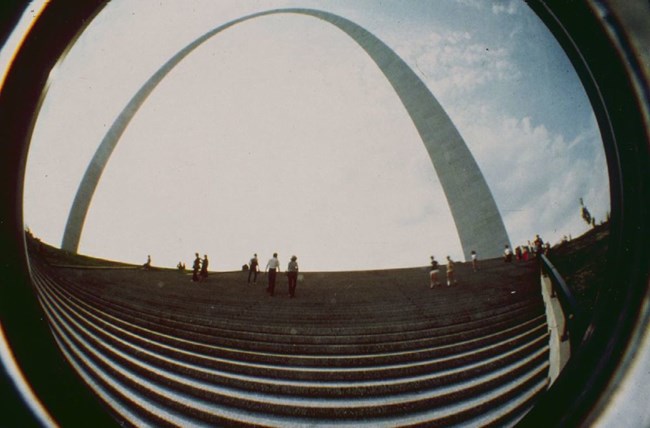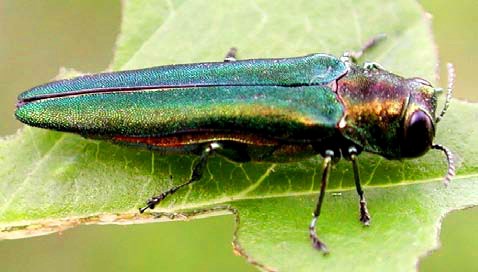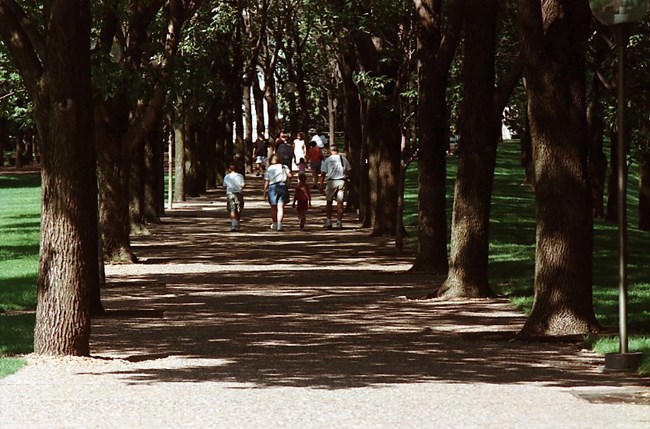Last updated: January 4, 2022
Article
Emerald Ash Borer at Gateway Arch National Park
Learn how a little green bug led to the removal of hundreds of trees on the Arch grounds, and how the National Park Service built the landscape back even better.

NPS photo
Installing the original landscaping
The landscape surrounding the Gateway Arch was developed at the same time as the Arch itself. The Gateway Arch architect, Eero Saarinen, collaborated with landscape architect Dan Kiley from the earliest stages of design planning. However, though the Arch was completed in 1965, the installation of the landscape was delayed for years due to lack of funding. As funding became available during the 1970s and early 1980s, the trees, grass, and other features were installed in phases. The landscaping deviated from Kiley’s original plans. For example, the walkways leading to the north and south ends of the park were originally supposed to be lined with Tulip Poplars. Those trees, however, were not locally available, and St. Louis horticulturists raised concerns that they would not do well in the urban environment. The monoculture species was therefore changed: first to Pin Oak, then to Rosehill Ash.

NPS Photo
Significance of the landscape
The landscaping on the Gateway Arch grounds has been widely celebrated as a triumph of landscape architecture. The landscape has been deemed a National Historic Landmark, protected under National Register Criteria A and C. It is recognized as one of the premiere examples of mid-century modern landscape architecture in the world. Because of this distinction, the National Park Service is tasked with preserving the designed landscape as a cultural resource. Learn more about the significance of this historic landscape here and here.|

Photographer: Leah Bauer, USDA FS Northern Research Station, Bugwood.org Original URL: http://www.forestryimages.org/browse/detail.cfm?imgnum=5473689 Shared under Creative Commons BY-NC 3.0 US
Emerald Ash Borer Arrives in America
Rosehill Ash trees were chosen to line the walkways of the Arch landscape partially because the species is very hardy and tolerant of pests, pollution, and disease. It was considered a good choice for a long-term, healthy urban landscape. The landscapers and horticulturists who recommended a monoculture planting of Rosehill Ash could never have predicted the devastating impacts Emerald Ash Borer (EAB) would bring a few decades later. The larvae of this small green beetle eat the spongy, nutrient-rich material just under the bark of ash trees. In their native China, EAB are a part of the food web – they have natural predators, and ash trees there have evolved protections, so the insects are generally deadly only to sick or diseased trees. In North America, however, these evolved protections do not exist. Nearly 100% of healthy trees infested with EAB here will die within just a few years. Though some North American birds can eat the beetles and their larvae (most notably Downy and Hairy woodpeckers), they don’t control the beetle population enough to limit the pests’ spread.
EAB’s relentless conquest of ash trees in American forests has been staggering. The beetle was first officially identified in the USA in Detroit, Michigan in 2002, though it may have arrived a few years earlier. By 2003, EAB had spread to nearby Ohio. By 2004, it was in Indiana. It was in Illinois in 2006, and Wisconsin and Missouri in 2008. By June of 2021 (the most recent data available at the time of this writing), the Missouri Department of Conservation confirmed EAB in 89 of Missouri’s 114 counties. The USDA confirms it in 35 states and the District of Columbia. There are no longer federal domestic quarantines to attempt to control its spread.

NPS Photo
Removing the Ash Trees
In 2010, the National Park Service decided to remove all the Rosehill ash trees on Gateway Arch National Park grounds in advance of Emerald Ash Borer’s inevitable arrival. This decision was carefully thought out. Though pesticide treatments to protect ash trees from EAB do exist, they are very expensive and need to be reapplied every couple of years. Since some Rosehill ash trees were showing age-related decline, it was considered a more prudent use of time and money resources to replace the trees with another species than to treat them.
Since the park grounds are recognized as a National Historic Landmark and the monoculture-lined walkways are considered a character-defining feature to this historically significant area, the Park Service was obliged to retain the monoculture-lined walkways in the next iteration of the landscape design.
What to Plant in Place of the Ash Trees?
Once it was decided that the Ash trees had to go, the next step was to determine which species should be chosen to replace them. The biggest priority was to fulfil the original design intent of landscape architect Dan Kiley. The monoculture tree also needed to be resistant to disease and pests, adaptable to the alkaline soils of the Arch grounds, and able to handle urban conditions (such as air and light pollution). The tree needed to grow quickly, but also needed to be sturdy – the park could not choose a tree that would lose branches and become hazardous in an urban location with hundreds of thousands of visitors a year. The National Park Service conducted an extensive public involvement and outreach program, meeting with nearly 1000 people in 11 public informational meetings. National Park Service staff and contractors, the CityArchRiver design team, the Missouri Department of Conservation, Missouri Botanical Garden, local arborists and nursery workers, and many others were all consulted.
From eight semifinalists (Miyabe maple, Freeman maple, ginkgo, Tulip poplar, London planetree, Trazel filbert, American linden, and Silver linden) three finalists were chosen: Gingko (Gingko biloba), Tulip poplar (Lilodendron tulipiferous) and London Planetree (Platanus acerfolia).The London planetree was finally chosen because it best fit all the necessary criteria. Historically, it was the second choice of Kiley and Saarinen.
When the grounds revitalization project was completed, the park contained 4,129 trees, more than doubling the total number of trees present before renovations. Outside of the monoculture-lined walkways, all other plantings in the new landscape utilized more diversity in species of trees. During the CityArchRiver project, the overall number of trees of a single species throughout the park was reduced even though the monoculture-lined walkway design was retained.

NPS Photo
Future Plans
Our grounds and maintenance crew preserves the historic landscape by pruning, mowing, watering, fertilizing, and conducting insect and weed control to help give desirable plants an advantage over undesirable plants. In addition to natural midwest growing challenges like temperature and rainfall extremes, our urban location brings a number of other difficulties, such as "heat islands" caused by concrete construction, poor soil conditions, limited space, and air pollution (though air pollution has improved in recent years).
Keeping the grounds healthy is a challenge, but it is one we are proud to take. Because the Arch grounds are protected as a National Historic Landmark, the historic landscaping of the Arch grounds will continue into the future, and landscape features that contribute to the park’s significance will be retained.
